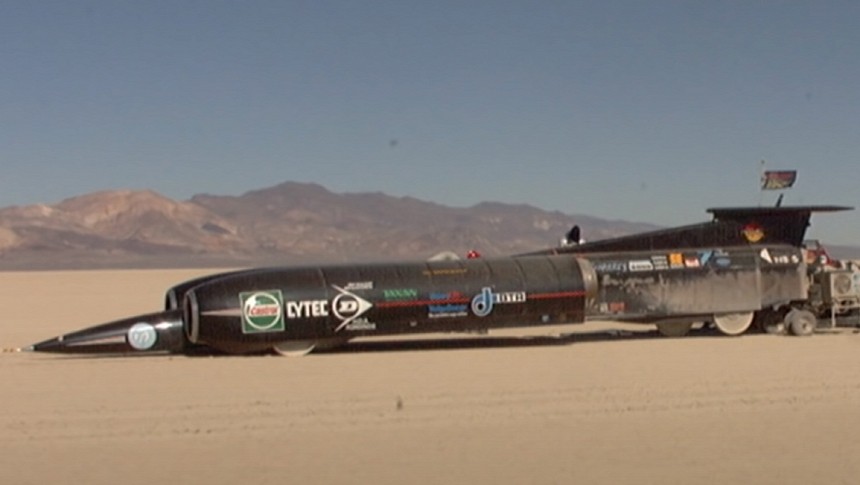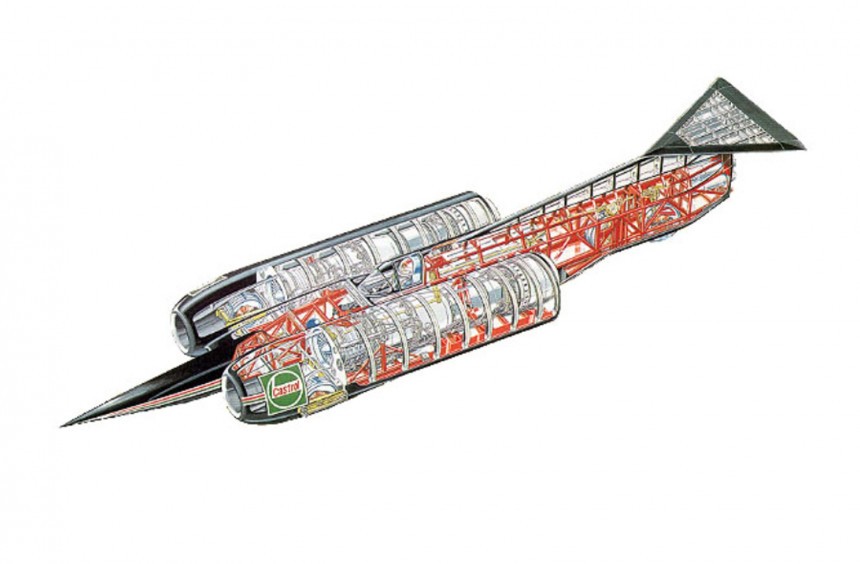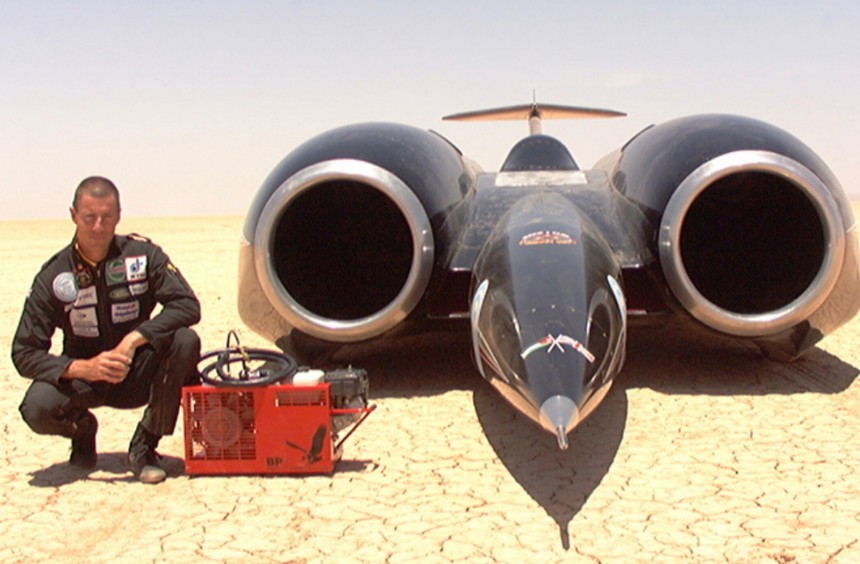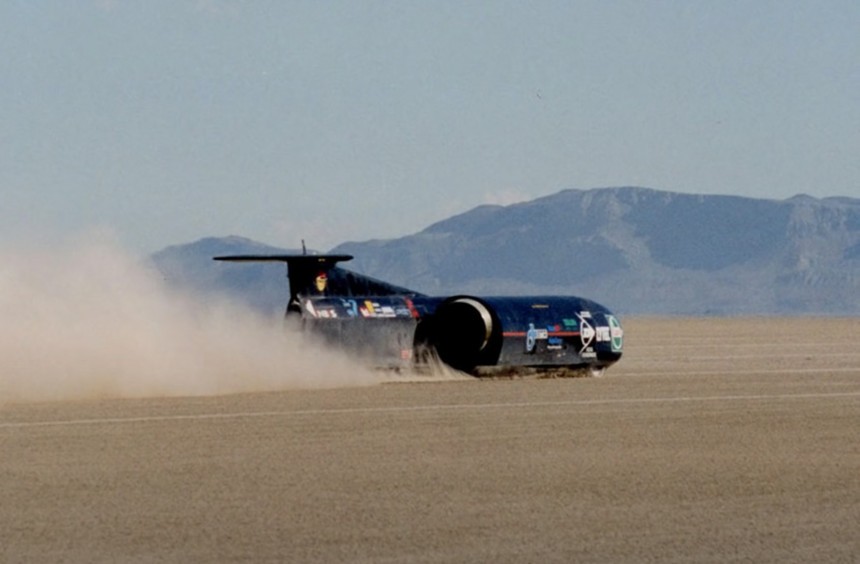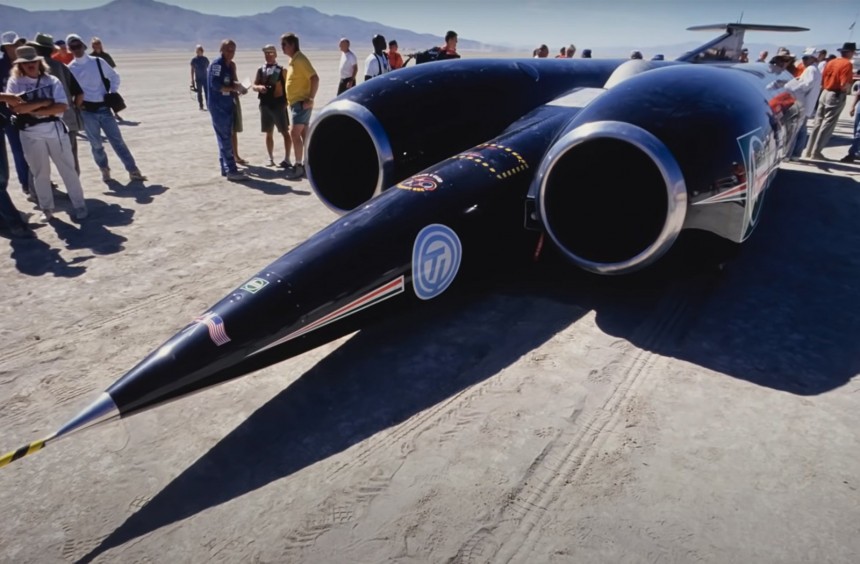Twenty-six years ago, in the spring of 1997, this outrageous rocket on wheels broke the sound barrier and became the fastest land vehicle ever built.
The automobile was created to revolutionize transportation, but as they did with horse-drawn carriages, some people have never ceased to devise ways to make cars go faster.
The first car that set a speed record was actually a French battery-electric vehicle (BEV) that reached 39.24 mph (63.15 kph) in 1898. The record was broken multiple times during the next few years, and with the advancements of the internal combustion engine over electric powertrains, the speed also rose exponentially.
In January 1904, Henry Ford himself drove the 999 – a custom race car powered by an 18.9-liter inline-four – to a speed of 91.37 mph (147.05 kph). The record was broken multiple times that year, and by the early-1960s, the quest to build the fastest land vehicle on planet Earth was taken to another level.
During that period, the Bluebird CN7 and the Spirit of America brought jet engine technology from the aircraft industry to the world of record-breaking land vehicles, raising the bar over the 400 mph (643 kph) mark.
But as audacious as those speeds were, in the 1990s, a team of daring speed addicts set their sights on creating a four-wheeled vehicle capable of achieving the unachievable: setting a new speed record by breaking the sound barrier on land.
Dubbed Thrust SuperSonic Car (or Thrust SSC, for short), the record-breaking vehicle was the brainchild of British entrepreneur and former world land speed record holder Richard Noble, who developed it with help from a dedicated team that included engineering masterminds Glynne Bowsher, Ron Ayers, and Jeremy Bliss.
A follow-up to the Thrust 2, the jet-power car that broke the land speed record in 1983, the SSC looked more like a wingless jet fighter than a car.
Yes, it had four wheels, but they were hidden underneath the gargantuan fuselage. The structure measured 154 feet (6.5 m) in length and 12 feet (3.7 m) in width, tipping the scales at nearly 20,000 pounds (10 tons) - as much as seven Toyota Corollas.
On each side of the jet fighter-like fuselage, the SSC was equipped with an afterburning Rolls-Royce Spey turbofan engine, an aircraft unit that powered a series of models, including the British F-4 Phantom II jet fighter.
The two engines could produce a net thrust of 50,000 lb-ft (223 kN), and if those figures weren't mind-blowing, the units gobbled up around 4.8 gallons (18 liters) of jet fuel every second. In more familiar terms, the SSC had a fuel economy of 0.05 mpg ( 4,850 liters/100 km), literally requiring a ton of fuel for each record-breaking run.
While building a behemoth like the SSC required a team of bright minds to pull off, the task of driving it at over 700 mph (1,126 kph) fell on one man.
Though Richard Noble had the required experience and was the land speed record holder at the time, he was approaching his 51st birthday, so he decided to hand down driving duties to Royal Air Force (RAF) Wing Commander Andy Green.
The pilot was used to breaking the sound barrier constantly with a fighter jet, but doing so with a huge, jet-powered car was a different (and scarier) experience. As he recalled in the YouTube video below, Green had to fight the SSC's tendency to veer to the left at high speeds by constantly adjusting the steering angle. At several points during the runs, he had to turn the yoke close to 90 degrees in order to keep the jet car straight.
After years of development, the SSC team traveled to the Al-Jafr desert in Jordan, where the car underwent a series of tests during the autumn of 1996 and spring of 1997.
With the tests proving successful, the team relocated to Nevada's Black Rock Desert, the site where the Thrust 2 established a new speed record fourteen years earlier.
The first official runs took place on September 25, 1997. With Green behind the yoke, the SSC reached an average speed of 714.144 mph (1,149.303 kph) over the required two runs. While this was more than enough to set a new world land speed record, it failed to achieve the goal of breaking the sound barrier.
Therefore, the SSC team returned to the Black Rock Desert on October 15 for another crack at it. This time, the Green pushed the SSC to 763.035 mph (1,223.657 kph), sending a massive sonic boom throughout the surrounding area. Its effects were reportedly felt 10 miles away, in the town of Gerlach, where the vibrations allegedly shook windows and knocked off sprinkler covers.
After the speed record was ratified, the SSC returned to England, where it was displayed at the Coventry Transport Museum alongside the Thrust 2.
Though it was temporarily relocated in 2015 to facilitate the building's renovation, the engineering masterpiece returned to the museum. Visitors can also experience Green's run in a state-of-the-art 4D motion simulator.
Since 1997, several attempts to build jet-powered cars able to break the SSC's record were made – including Andy Green's Bloodhound project – but, unfortunately, none were successful.
Twenty-six years after its record-breaking runs, the Thrust SSC remains the fastest car ever built and the only one that broke the sound barrier.
The first car that set a speed record was actually a French battery-electric vehicle (BEV) that reached 39.24 mph (63.15 kph) in 1898. The record was broken multiple times during the next few years, and with the advancements of the internal combustion engine over electric powertrains, the speed also rose exponentially.
In January 1904, Henry Ford himself drove the 999 – a custom race car powered by an 18.9-liter inline-four – to a speed of 91.37 mph (147.05 kph). The record was broken multiple times that year, and by the early-1960s, the quest to build the fastest land vehicle on planet Earth was taken to another level.
During that period, the Bluebird CN7 and the Spirit of America brought jet engine technology from the aircraft industry to the world of record-breaking land vehicles, raising the bar over the 400 mph (643 kph) mark.
But as audacious as those speeds were, in the 1990s, a team of daring speed addicts set their sights on creating a four-wheeled vehicle capable of achieving the unachievable: setting a new speed record by breaking the sound barrier on land.
A huge jet-powered monster
A follow-up to the Thrust 2, the jet-power car that broke the land speed record in 1983, the SSC looked more like a wingless jet fighter than a car.
Yes, it had four wheels, but they were hidden underneath the gargantuan fuselage. The structure measured 154 feet (6.5 m) in length and 12 feet (3.7 m) in width, tipping the scales at nearly 20,000 pounds (10 tons) - as much as seven Toyota Corollas.
On each side of the jet fighter-like fuselage, the SSC was equipped with an afterburning Rolls-Royce Spey turbofan engine, an aircraft unit that powered a series of models, including the British F-4 Phantom II jet fighter.
The two engines could produce a net thrust of 50,000 lb-ft (223 kN), and if those figures weren't mind-blowing, the units gobbled up around 4.8 gallons (18 liters) of jet fuel every second. In more familiar terms, the SSC had a fuel economy of 0.05 mpg ( 4,850 liters/100 km), literally requiring a ton of fuel for each record-breaking run.
Driven by an Air Force pilot
Though Richard Noble had the required experience and was the land speed record holder at the time, he was approaching his 51st birthday, so he decided to hand down driving duties to Royal Air Force (RAF) Wing Commander Andy Green.
The pilot was used to breaking the sound barrier constantly with a fighter jet, but doing so with a huge, jet-powered car was a different (and scarier) experience. As he recalled in the YouTube video below, Green had to fight the SSC's tendency to veer to the left at high speeds by constantly adjusting the steering angle. At several points during the runs, he had to turn the yoke close to 90 degrees in order to keep the jet car straight.
The record-breaking runs
With the tests proving successful, the team relocated to Nevada's Black Rock Desert, the site where the Thrust 2 established a new speed record fourteen years earlier.
The first official runs took place on September 25, 1997. With Green behind the yoke, the SSC reached an average speed of 714.144 mph (1,149.303 kph) over the required two runs. While this was more than enough to set a new world land speed record, it failed to achieve the goal of breaking the sound barrier.
Therefore, the SSC team returned to the Black Rock Desert on October 15 for another crack at it. This time, the Green pushed the SSC to 763.035 mph (1,223.657 kph), sending a massive sonic boom throughout the surrounding area. Its effects were reportedly felt 10 miles away, in the town of Gerlach, where the vibrations allegedly shook windows and knocked off sprinkler covers.
The Thrust SSC today
Though it was temporarily relocated in 2015 to facilitate the building's renovation, the engineering masterpiece returned to the museum. Visitors can also experience Green's run in a state-of-the-art 4D motion simulator.
Since 1997, several attempts to build jet-powered cars able to break the SSC's record were made – including Andy Green's Bloodhound project – but, unfortunately, none were successful.
Twenty-six years after its record-breaking runs, the Thrust SSC remains the fastest car ever built and the only one that broke the sound barrier.
